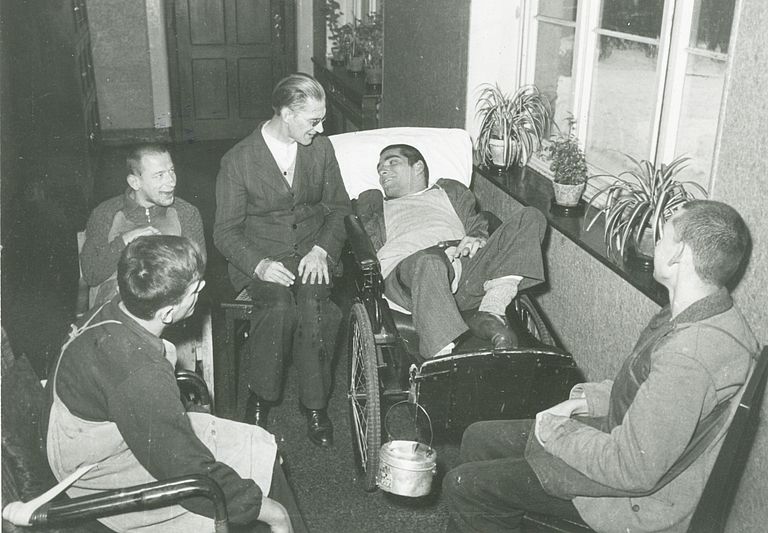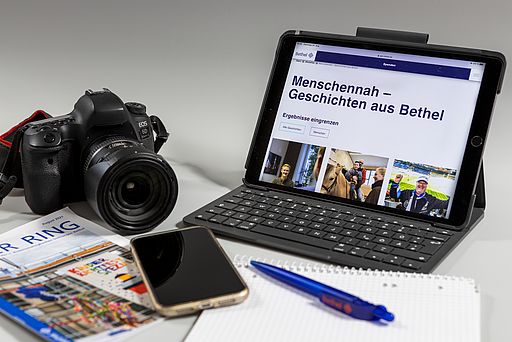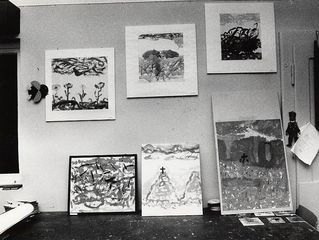
Close to people | Stories from Bethel
Richard Dege: Witness to an eventful century
Richard Dege was a special man who lived a remarkable life: he was born in Goslar in 1924, into a difficult - and between 1933 and 1945 even life-threatening - time. Physically severely impaired, he experienced the comprehensive development of the German welfare system of the 20th century first-hand. It is the unusual life story of a man who always remained optimistic and laughed a lot, as contemporary witnesses report. And who, at an advanced age, learnt to paint so well with his foot that he became a minor celebrity.
In January 1932, the then seven-year-old Richard Dege was brought to Bethel by his parents. They hoped that their son would be cared for and supported according to his needs. The boy suffered from a cerebral movement disorder with seizures, caused by brain damage at birth. Richard Dege was admitted to Haus Patmos, where he lived for the next twelve years.
Inclusion, participation or even personal self-realisation, which characterise Bethel's work today, were unknown concepts at the time. But even then, there were endeavours at Bethel that corresponded precisely to these goals. The staff went to great lengths to support Richard Dege so that he could participate in the life of the institution as much as possible. This also meant that, like all children at Bethel, he received regular schooling right from the start. During the years of fascist Germany and the Second World War, the boy was able to remain at Bethel in his familiar surroundings, undisturbed by the reprisals of the National Socialists.
In the post-war years, Richard Dege witnessed a new development: awareness of disability-friendly living increased, even if the circumstances at the time were still very different from today's possibilities. Richard Dege's file contains a number of references that indicate how much interest there was in an "inclusive community". One example of this is the purchase of a pushchair made especially for him. This chair made Richard Dege more mobile and enabled him to take part in group activities.
When there was a paradigm shift in healthcare in Germany in the 1970s, Richard Dege benefited greatly from these changes. An American physiotherapist practised sitting for short periods with him. After numerous individual lessons, he mastered this skill - a huge step forward for him, as he had previously only been able to move lying down in his wheelchair. As natural as the use of physiotherapy is today, it was special and new back then, when individual support and treatment options were not yet the norm.
With the help of a deacon, Richard Dege finally even managed to express his creativity: despite his paralysis, he learnt to paint pictures with difficulty and perseverance. He held the brush between his toes. With this talent, he became a minor celebrity in and around Bethel. His colourful works of art were sold many times over. He did not keep the proceeds, but used them to sponsor a young boy in India.
At that time, he was given a single room in Jabbok House for the first time - a change he was delighted with: "I think it's the right thing to do because you can live on your own and invite someone round more easily. [...] I hadn't imagined it would be this nice." Up to this point, the almost 61-year-old had never known anything other than the large dormitories. He even had praise for the sanitary facilities - and also thought of the staff: "The bathrooms are nice too. You can raise and lower the bathtub. To get in, it's at the bottom; once you're in, it's automatically raised so that the employees don't have to bend down so low when they wash us. I think that's great!" Richard Dege was delighted to have his own fridge, wardrobe, radio, television and record player in the communal areas.
He was only allowed to have a room to himself for one year. Richard Dege died on 17 September 1986 at the age of 62. He spent 54 years at Bethel - almost his entire life. In 1988, his memories, which he had passed on orally over the course of his life, were published as a book.
Text: Alina Lisanne Ebmeyer | Photo: Bethel main archive
This story simply told
Richard Dege was a special man. He came to Bethel in 1932. He was 7 years old and physically very impaired. Despite his paralysis, he learnt to paint pictures. He held the brush with his foot. This is how he became known in Bielefeld. He earned some money with his paintings. He used this to sponsor a boy in India.
Would you like to find out more about Bethel's history?
About the institution
Bethel Main Archive
Bethelplatz 2
33617 Bielefeld
Telephone: 0521/144-3506
E-mail: geschichte[at]bethel.de
Offers & services
The main archive is the contact point for everything to do with the history of the v. Bodelschwingh Foundation Bethel. The department is responsible for all archiving tasks for the Bethel, Sarepta and Nazareth foundations. Everything that documents the development of the foundations since their establishment is permanently secured, made accessible, scientifically utilised and presented here: Files, official records, digital documents, maps, leaflets, posters, printed matter, films, slides, photos and original artefacts.







